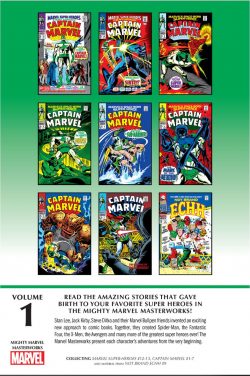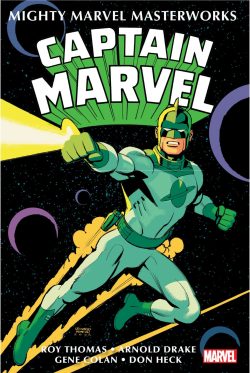

By Stan Lee, Roy Thomas, Arnold Drake, Gene Colan, Don Heck & various (MARVEL)
ISBN: 978-1-3029-4889-4 (PB/Digital edition)
It’s a year of many anniversaries for Marvel, and 1968 marks a couple of truly significant ones. It was the year the company finally broke free of a restrictive distribution deal and began an explosive expansion that led to market dominance. The other was more symbolic and seminal: the company secured the rights to an evocative and legendary name which it has successfully exploited ever since. Moreover, that name led to the soft introduction of a character who has become one of the faces of the modern Marvel Age.
Happy birthday Mar-Vell and Carol…
The stories re-presented here are timeless and have been gathered many times before but today we’re enjoying another example of The Mighty Marvel Masterworks line: designed with economy in mind and newcomers as target audience. These books are far cheaper, on lower quality paper and smaller – like a paperback novel. Your eyesight might be failing and your hands too big and shaky, but at 152 x 227mm, they’re perfect for kids. If you opt for digital editions, that’s no issue at all.
After years as an also-ran and up-&-comer, by 1968 Marvel Comics was in the ascendant. Their sales were catching up with industry leaders National/DC Comics and Gold Key, and they had finally secured a distribution deal that would allow them to expand their list of titles exponentially. Once the stars of “split-books” Tales of Suspense (Iron Man & Captain America), Tales to Astonish (The Hulk & Sub-Mariner) and Strange Tales (Doctor Strange & Nick Fury, Agent of S.H.I.E.L.D.) all won their own titles, the House of Ideas just kept on creating. One dead-cert idea was a hero named after the company – and one bringing popular cachet and nostalgic pedigree as well.
After the notorious decade long DC/Fawcett court case that began in 1940, the title Captain Marvel disappeared from newsstands. In 1967, during the superhero boom and “camp” craze generated by the Batman TV show, publisher MLF seemingly secured rights to the name and produced a number of giant-sized comics. Their star was an intelligent alien robot who could fly, divide his body into segments and shoot lasers from his eyes.
Despite a certain quirky charm, and being devised by comics veteran Carl (Human Torch) Burgos, the feature failed to attract a large following. On its demise, the name was quickly snapped up by expansionist Marvel Comics Group.
Marvel Super-Heroes was a brand-new title: it had been giant-sized reprint comic book Fantasy Masterpieces: combining monster and mystery tales with Golden Age Timely Comics classics, but with the 12th issue it added an all-new experimental section for characters without homes. These included Inhuman Medusa, Ka-Zar, Black Knight and Doctor Doom, along with new concepts like Guardians of the Galaxy, Phantom Eagle and, to start the ball rolling, a troubled alien spy sent to Earth from the Kree Galaxy. He held a Captain’s rank and his name was Mar-Vell.
This cosmically conceived, kid-friendly collection offers that origin adventure from Marvel Super-Heroes #12-13, the contents of Captain Marvel #1-7 plus a humorous take from Not Brand Echh #9: collectively spanning cover-dates December 1967 to August 1968.
Crafted by Stan Lee, Gene Colan & Frank Giacoia, the initial MS-H 15 page-instalment ‘The Coming of Captain Marvel!’ The tale derived directly from Fantastic Four #64-65, wherein the quartet defeated a super-advanced Sentry robot marooned on Earth by a mythical and primordial alien race, only to be attacked by a high official of those long-lost extraterrestrials in the very next issue!
After defeating Ronan the Accuser, the FF heard no more from the far from extinct Kree, but the millennia-old empire became once again interested in Earth. Dispatching a surveillance mission, the Kree wanted to know everything about us. Unfortunately, the agent they chose was a man of conscience, whilst his commanding officer Colonel Yon-Rogg was his ruthless rival for the love of the ship’s medical officer Una.
No sooner has the dutiful operative made a tentative planet-fall and clashed with the US Army from a local missile base (frequently hinted at as being Cape Kennedy) than the instalment ends. Stan & Gene had set the ball rolling leaving Roy Thomas to establish the basic ground-rules in the next episode.
Colan remained, this time with Paul Reinman inking. ‘Where Stalks the Sentry!’ sees the spy improving his fantastic weaponry before a blatant attempt by Yon-Rogg to kill him collaterally destroys a light aircraft carrying scientist Walter Lawson to that military base.
Assuming Lawson’s identity, Mar-Vell infiltrates “The Cape” but arouses the suspicions of security Chief Carol Danvers. He is horrified to discover the Earthlings are storing the Sentry (defeated by the FF) on site. Yon-Rogg, sensing an opportunity, reactivates the deadly mechanoid. As it goes on a rampage, only Mar-Vell stands in its path…
That’s a lot of material for 20 pages but Thomas & Colan were on a roll. With Vince Colletta inking, the third chapter was not in Marvel Super-Heroes but in the premiere issue of the Captain’s own title – released for May 1968. ‘Out of the Holocaust… A Hero!’ is an all-action thriller, detailing the Kree-man’s victorious clash with the superbot, but which still found space to establish twin sub-plots. Succeeding issues would focus on “Lawson’s” credibility and Mar-Vell’s inner doubts as the faithful Kree soldier rapidly loses faith in his own race and falls under the spell of the strangely beguiling humans…
The Captain’s first foray against a super-villain comes in the next two issues as we learn the Kree and Skrull Empire have been intergalactic rivals for eons, and the shapeshifters now need to know why there’s an enemy soldier stationed on neutral Earth.
Despatching their own top agent, ‘From the Void of Space Comes the Super Skrull!’ and the resultant battle almost levels the entire state before bombastically concluding with the Kree beaten, captured and interrogated. A month later he rallies ‘From the Ashes of Defeat!’ and spectacularly triumphs, whilst on the orbiting home front the romantic triangle sub-plot intensified as Yonn-Rogg looked for ways to send Mar-Vell to a justifiable death…
Issue #4 saw the secret invader clashing with fellow anti-hero Prince Namor the Sub-Mariner in ‘The Alien and the Amphibian!’ even as Mar-Vell’s superiors make increasingly ruthless demands of their reluctant agent.
Captain Marvel #5 saw Arnold Drake & Don Heck assume the creative chores (with John Tartaglione on inks) in cold-war monster-mash clash ‘The Mark of the Metazoid’, wherein a mutated Soviet dissident is forced by his militaristic masters to kidnap Walter Lawson (that’s narrative symmetry, that is).I ssue #6 then places the Captain ‘In the Path of Solam!’: battling a marauding sun-creature even as Carol Danvers gets ever-closer to proving that something’s not right with the enigmatic consultant Lawson. Meanwhile, the man impersonating him is forced to prove his loyalty to his species by unleashing a Kree bio-weapon on an Earth community in ‘Die, Town, Die!’ However, all is not as it seems because murderous animate Quasimodo, the Living Computer is also involved…
To Be Continued…
Wrapping up this first volume is a burst of light relief from Marvel’s sixties parody comic Not Brand Echh From # 9, ‘Captain Marvin: Where Stomps the Scent-ry! or Out of the Holocaust… Hoo-Boy!!’ finds Thomas, Colan & Frank Giacoia wickedly reimagining the origin. It’s either funny or painful depending on your attitude…
Mar-Vell and Carol Danvers have both been Captain Marvel and starred in some our art form’s most momentous and entertaining adventures. Today’s multimedia madness all started with these iconic and evergreen Marvel tales, and it’s never too late for you to join the ranks of the cosmic cognoscenti…
© 2023 MARVEL.
